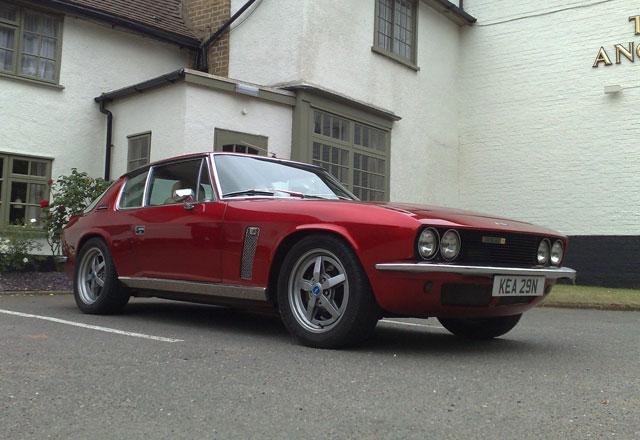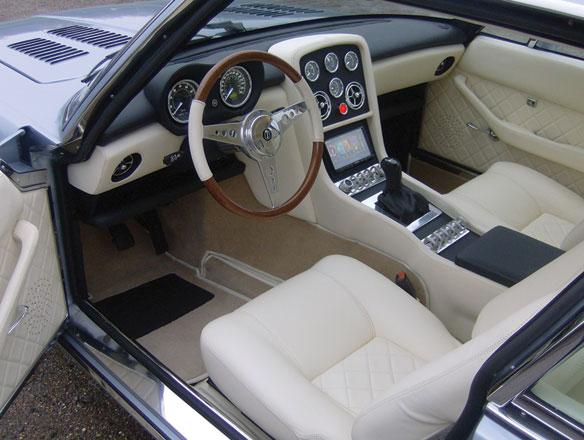You are here
Revival and renaissance
By Ghaith Madadha - Jan 12,2015 - Last updated at Jan 12,2015

Promising modern V8 muscle and refinement with unmolested classic style and elegance, the hand-built Jensen Interceptor R is a re-engineered and re-furbished resurrection of a much-loved classic.
The height of elegantly indulgent yet unpretentious luxury and sophistication in its 1960s and 1970s glory days, the Interceptor claimed an impressively eclectic list of A-list celebrity owners including Frank Sinatra, Clark Gable, Tony Curtis, Dusty Springfield and Farah Fawcett.
Effortlessly charming yet moody and grand but unostentatious, the Interceptor is an enduringly desirable classic that is now revived and modernised by Jensen International Automotive (JIA), a firm established by Jensen-enthusiast businessmen and engineers in 2010.
Seductively graceful and uncomplicatedly charismatic, the Jensen Interceptor was originally launched in 1966 and designed by Carrozzeria Touring in Milan, with early bodies built by Vignale coachbuilders in Turin for the now defunct Jensen Motors of West Bromwich, UK.
Powered by a brutishly effective and un-complex American V8 — like mane bespoke and exotic British and Italian cars of its time, the Interceptor design language and moody sense of dynamic tension was however more of Italian grand tourers of its milieu — like the Iso Grifo — than British ones.
Modernised by Oxfordshire-based JIA the reborn Interceptor R subtly but extensively improves on the original’s design and driving character with more modern components and techniques.
British built and rebuilt
A viable real-world daily driver that captures the charm of the swinging sixties, the Interceptor R is an altogether different, more charismatic, elegant and exclusive car for the client able to buy or already in possession of the latest exotic high performance and luxury cars.
With a team of experienced technicians, engineers and restorers, the Interceptor R offers improved handling, performance, refinement and reliability, and is re-built from either JIA-provided or client-sourced 1971-76 Mk3 or 1969-71 Mk2 donor cars.
Completed in 26-30 weeks for GBP £150,000, donor cars are first fully stripped down and inspected before the shell is repaired, the restored seam sealed, primed and painted to preference.
Fitted with a modern General Motors LS3 6.2-litre V8 in place of original 6.3- and 7.2-litre Chrysler engines, the Interceptor R’s rear live-axle is replaced with independent rear suspension.
Almost unchanged, keen observers will however notice the Interceptor R’s black grille slats, wider exhaust tips, lower front air dam and wire mesh intakes and side vents, while rounded indicator lights replace rectangular originals.
The Interceptor R also gets rechromed details, new steel bumpers, sill covers and kick-plates, while 17-inch (43.18cm) replicas replace original’s 15-inch (38.1cm) alloy wheels to accommodate modern brake discs, six-pot front callipers and wider lower profile 235/55VR17 tyres.
The demo car driven featured optional 255/50VR17 rear tyres and discretely wider rear wheel-arches from the supercharged version.
Italian glamour
With a name as dramatic as its design, the Interceptor is edgy and dramatically predatory, but is classy rather than overstated. With a long and low bonnet allowed by its compact OHV V8 engine design and front-mid position, the Interceptor has an airy and upright charisma, with low waistline, big glasshouse, distinctive wraparound glass hatch and thin pillars for excellent visibility to better place it on road that a modern GT, despite its indulgently long bonnet. Sitting low and close to the fixed steering wheel and door, the Interceptor R offers excellent front headroom, useable rear seats, and comfortably padded and luxuriously upholstered and double-stitched leather-bound seats for long journeys. .
Brimming with debonair style, presence and a sense of occasion, the Interceptor R seemed to bring out the courteous side of other road users, whereas a more ostentatious modern personal luxury coupe might have the opposite effect.
Along with luxurious reupholstery, the Interceptor R features an aircraft-like line of new gauges set deep within an upright refurbished and leather-bound dashboard, and large user-friendly buttons, rotary dials, chrome accents, brushed aluminium console and three-spoke period leather-steering wheel. Also included are new electrics, refurbished seals and original-style halogen headlights. Dramatic, luxurious and exotic, the Interceptor R exudes presence and a sense of occasion. Fitted with rear-anchored seatbelts, one can opt for B-pillar anchoring.
Modern American muscle
With modern and more evolved American muscle under the bonnet in the form of the same light and compact 6.2-litre V8 engine that powers the Chevrolet Camaro SS — replacing its lazy and heavy period cast-iron Chrysler V8s — the Interceptor R is more powerful and efficient, and offers a robust and low maintenance power-train.
True to the original’s character, the new V8 is a burbling and bass-rich brute with a insistent bellow at full chat, which is better enjoyed owing to less soundproofing than a modern clinical GT coupe. Mounted further back for better within wheelbase weighting, the Interceptor R’s 6.2 V8 429BHP at 5,900rpm and 424lb/ft torque at 4,600rpm.
With a modest-by-modern-standard 1.6-tonne weight and deep reservoir of torque from tick-over to redline, the Interceptor R is effortlessly and muscularly flexible throughout, and punches through high winds and 1960s aerodynamics with vigorous determination. Digging its sticky rear tyres into the tarmac the interceptor R leaps through the 0-100km/h benchmark in 4.5 seconds, and onto a 255km/h maximum.
With ample reserves of torque and linear delivery, the Interceptor R offers daily flexibility and punchy top-end power. The early build demo car driven featured a smooth and responsive four-speed automatic gearbox, but this has been replaced for production with a better integrated, smoother and more responsive six-speed automatic, or six-speed manual.
Newly independent
The Interceptor R’s most significant improvement is, however, its Jaguar XJ-S-sourced lower wishbone and twin damper independent suspension, which replaces the outdated original live axle rear set up. Able to travel independently of the opposing side, the Interceptor R’s independent suspension provides enhanced refinement and handling.
Driven on various urban, country and motorway routes, the Interceptor R’s ride is confident, settled on rebound and comfortably supple over imperfections but not detached.
The Interceptor R’s tyre choice provides improved handling and braking without sacrificing comfort and practicality. Its revised and modern brakes are highly effective but require firmer pedal input owing to the original servo assistance still in use.
Reconciling a GT’s luxury, long-distance and sporting requirement, the Interceptor R’s revised suspension, springs, bushes and tightened-up and firmer steering deliver a connected and responsive but stable and refined drive, especially for a car of its vintage. With a natural feel and fluency, the Interceptor R is an anecdote to overly heavy, assisted and synthesized modern GTs.
The Interceptor R’s meaty steering delivered good feel and feedback, and tidier turn-in than expected, but a taller ratio requires more input. With more cornering lean than modern cars, the Interceptor R is however balanced, controlled and settles reassuringly from weight transfers, and provides a progressive and transparent feel to its high lateral grip limits. Wind noise was less than expected for its age.
TECHNICAL SPECIFICATIONS
Engine: 6.2 litre, front-mid, all-aluminium V8 cylinders
Bore x Stroke: 103.25 x 92mm
Compression: 10.7:1
Valve train: 16 valve, OHV, fuel injection
Gearbox: 7-speed automatic, RWD, 2.89:1, limited slip differential
Power, BHP [kW]: 429 [321] @ 5,900rpm
Torque lb/ft (Nm): 424 (575) @ 4,600rpm
Maximum engine speed: 6,600rpm
0-100km/h: 4.5-seconds
Top speed: 255km/h
Length: 4,700mm
Width: 1,700mm
Height: 1,250mm
Wheelbase: 2,670mm
Kerb weight: approximately 1,600kg
Suspension, F: Double wishbone, adjustable Spax coil-over dampers, anti-roll bar
Suspension, R: Independent, lower wishbone, twin adjustable Spax coil-over dampers
Steering: PAS rack and pinion
Brakes, F/R 6 piston callipers, ventilated discs 330mm/1 piston callipers, discs, 280mm
Tyres, F/R: 235/55VR17/255/50ZR17 (optional)
Price, UK: £150,000
Related Articles
Gliding with cosseting comfort and latently potent rumble from its mighty V8 along Jebal Ali backroads, the UAE’s and Middle East’s first JI
An uncannily familiar and satisfying combination of classic design and modern muscle, the Range Rover Chieftain is Banbury, UK-based Jensen
Capturing the glamour, charisma and immersive connection of cars from a bygone era and often lacking in disconnected, over-sanitised, overwe



















